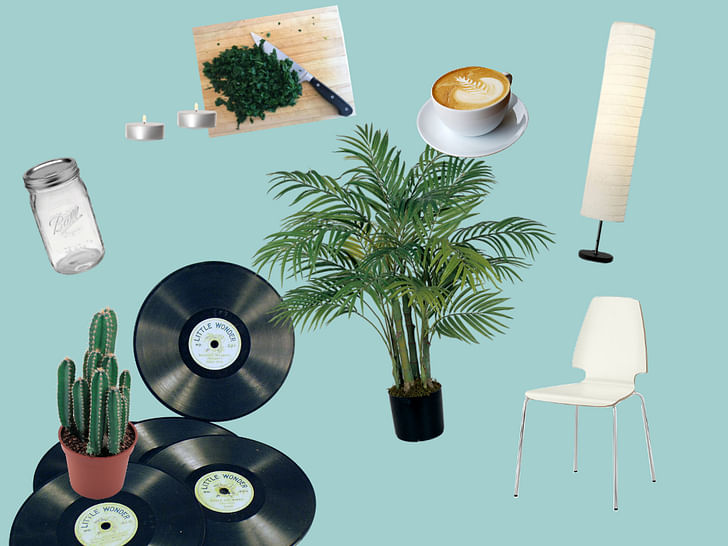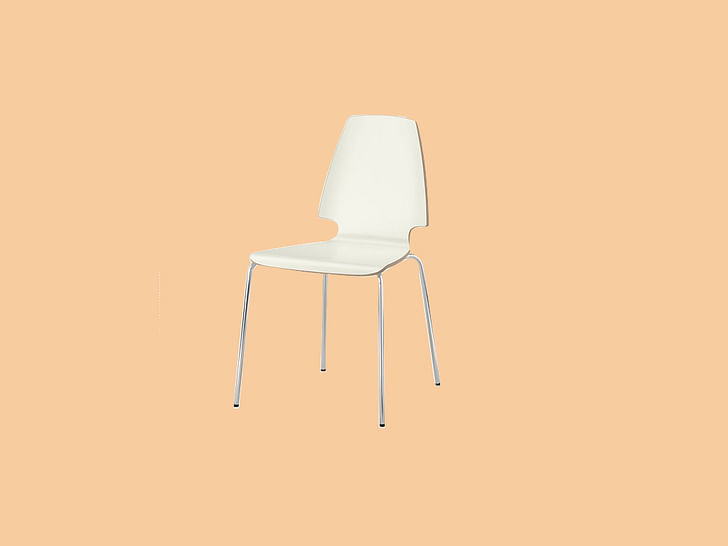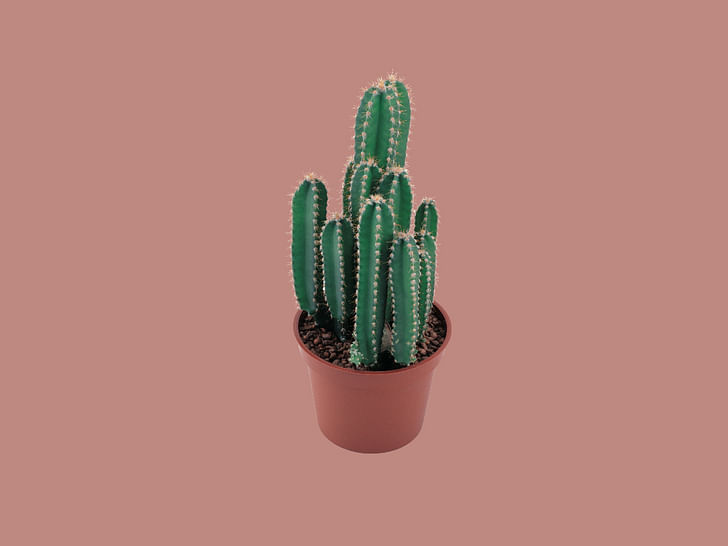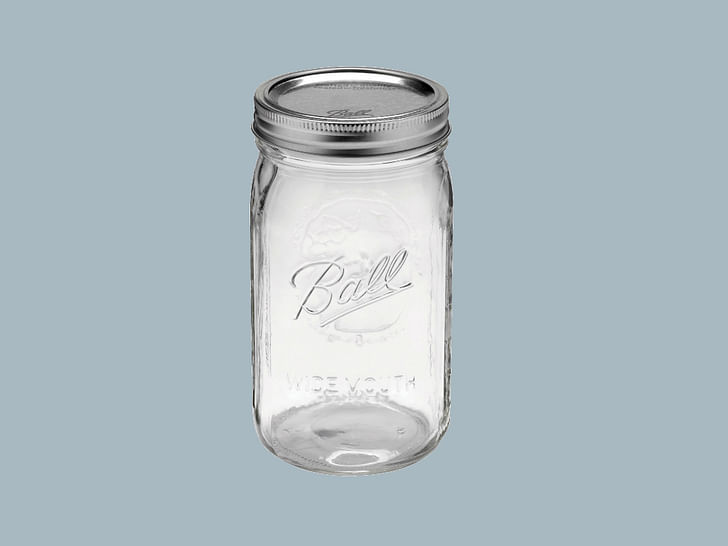

“Work, work, work, work, work, work,” instructs Rihanna as we drive through the mountain pass; her dancehall, reggae-pop anthem to staying on the grind despite poor returns on libidinal investment providing the tempo for my own frantic attempts to capture any last emails before I abandon the world of 3G for cacti, a meteor shower, and a cheap Airbnb.
Actually, not that cheap—about $150 each for the weekend—but inexpensive for the area. A couple of weeks before, my roommate and I had spent a few hours scrolling through the listings trying to decide which to book. Aesthetics were the big unknown factor because online all the houses looked pretty much the same. Small houses built in the post-war boom that have since been gutted—carpets removed, walls demolished, windows inserted—and decorated in a particular regional kitsch: 1950s Palm Springs meets John Lautner, Liberace, Gram Parsons and Urban Outfitters. But as much as the decor is Southern California desert-specific, it’s also standard-issue Airbnb, with elements that could be equally at home in New York or Berlin, from the potted plants to the plywood furniture to the record collection to the Ikea staples.

My first thoughts on arrival were about how smart Airbnb was to offer professional photography services to its “hosts.” Wide-angle, color-corrected (and perhaps photoshopped) photos really can do wonders for a space. IRL, it was clear that the furniture was almost all DIY, as were the bibelots. The desk sat on cinder block supports. The headboard was a sheet of plyboard with fabric inexpertly stapled to its front. The kitchen counters were also plyboard, but covered with a strange, concrete-colored paint applied thickly. (After noticing the latter, water damage was both expected and detected.) Rather than slip into the background, as the various furniture pieces and decorative objects did when arranged carefully in an image, the poorly-applied veneers brought these objects into sharp focus in person.
homeyness hovered in the air, without ever touching down into realityWhile the furniture and other objects appeared familiar as image—they had a gossamer tether to both lifestyle magazines and my own home, filled as it is with the requisite cacti and Ikea textiles—a gap between shadow and substance appeared in their physical presence, like in a fun house or stage set. In other words, I could perceive the labor involved in their manufacture, but unlike a designer piece of furniture or an antique, the labor was shoddy, the craftsmanship poor. They both evoked bourgeois taste—in its contemporary form, as typified by Pinterest boards or Instagram feeds—and fell short of achieving it, in that the DIY-aspect felt cheap and shoddy rather than “artisanal” or “handicraft.”
“This is not my beautiful house,” I may have thought. And, in fact, it was clearly nobody’s house, but exclusively a rental property. At the same time, the general adherence to a familiar aesthetic achieved an unstated, but presumed goal: homeyness hovered in the air, without ever touching down into reality.

This manufactured sense of homeyness likewise shimmers on the surface of the glossy world rendered by Airbnb advertisements. Here all users appear the same: happy travelers and hosts, meeting new people and pocketing (or saving) some cash in the meantime. But who is actually the typical Airbnb user? According to Airbnb's published data, there isn’t one. Rather, Airbnb host demographics are something of a mirror for broader socioeconomic trends.
In other words, Airbnb is being used, in part, to increase the wealth of the already-wealthy: individuals and families that own more than one property, or who can afford to build an extension to their house. Then, on the flip side, Airbnb has become a survival strategy for individuals struggling to make ends meet in increasingly unaffordable cities. Today, norms of stable residency, whether publically subsidized or privately owned, are rapidly being replaced and undone. A new context is emerging in which a renter is likely to rent out their apartment and return to their parents’ house in order to survive a job loss;The sharing economy both responds to, and helps facilitate, the extension of precarity as a generalized condition or a landlord to evict a tenant in order to make more by listing the unit as a vacation rental, driving up rents in the adjacent area in the meantime. Around the world, rents are rising but wages are stagnating. The sharing economy, in this sense, both responds to, and helps facilitate, the extension of precarity, or in the words of Judith Butler, the “politically induced condition in which certain populations suffer from failing social and economic networks of support,” as a generalized condition.
For example, Airbnb has found that 56 percent of San Francisco hosts use the income generated to help pay their mortgage or rent, while 42 percent use it to pay for basic living expenses. In New York, 62 percent of hosts said Airbnb enabled them to stay in their homes. Nearly half of Airbnb hosts in Berlin earn below the median income. In Barcelona, that number jumps to 75 percent.

In Airbnb’s eyes, such figures speak to how the company is contributing to local economies. “This study shows that Airbnb is making cities across the UK stronger and providing an economic boost to residents at the same time,” they write. According to this perspective, without Airbnb, these people would lose their home, or default on their mortgage, or even go hungry. But that would mean that Airbnb and other disruptive technologies don’t actually disrupt, they simply add new income-earning opportunities.
We've kept the feeling of being at home anywhereYet recent research has shown the Airbnb contributes to London’s housing crisis by allowing landlords to skirt regulations; correlates to an increase in evictions in San Francisco, where landlords evict renters so they can put a unit up for short-term rental; and drives up rents in Berlin. In short, the economic impact of Airbnb fits into—and exacerbates—existing trends towards a widening gap between the rich and poor. Wealthy individuals are able to further capitalize on property assets, in the process driving up rent for poorer urban residents, who then are forced to rent their own apartment to make ends meet. It’s a boon for the rich, a coping mechanism for the poor. In the meantime, 'home', already an indeterminate metonym, gains new associations.
"We've kept the feeling of being at home anywhere," states Brian Chetsky, the founder of Airbnb. But of course, that’s not exactly true. As the comedian George Carlin has said, “Did you ever notice when you go to somebody else's house, you never quite feel a hundred percent at home? You know why? No room for your stuff. Somebody else's stuff is all over the goddamn place!”

Step one of converting your home or apartment into a rentable asset is to clear away space for other people’s stuff. And if it’s a long-term, income-generating initiative: reduce your stuff to the bare minimum (not just what you don’t want stolen, but also the too-personal signifiers that you neither want strangers to see, nor do strangers want to see). In the sharing economy, the house is still just “a pile of stuff with a cover on it,” but the stuff itself has to be necessarily reduced to the most basic, most generic, and most essential in order for the cover to be marketable.
At the same time, this reduced-stuff has to maintain an aura of homeyness, which is typically constructed precisely through the presence of (personal) stuff. It’s a difficult design challenge. a cozy utopia of lattes, upcycling, and Diptyque candlesThink of it as a decorated shed turned inside out, with the communicative aspect in the objects rather than the exterior (which, it should be said, is rarely even depicted in images on Airbnb). Or, rather, the Airbnb listings page as the Strip, the 1080p images as your personal neon sign, and your apartment as the casino.
Once you’ve cleaned out your house, you should probably buy new stuff. But since you don’t want to spend too much for fear of diminishing returns, do as much on your own as possible. Enter the DIY-ethos, divested of its former-radicality and punk-aesthetic. And, in turn: the standard, templatized aesthetics of Pinterest and Instagram, which provide not a sense of home-specific, but rather home-generalized and -indeterminate—a cozy utopia of lattes, upcycling, and Diptyque candles.

In The Arcades Project, Walter Benjamin describes the origins of the modern interior in the 19th century where, “for the private citizen, for the first time the living-space became distinguished from the place of work.” Today, as the bedroom increasingly becomes a space for work as well as play, socialization and sleep, history seems to be coming full circle. Once again, work and leisure cohabitate space. According to a 2009 poll of 329 British workers, one in five people spend between two and ten hours working from bed per week, although the actual number is probably higher. While some bemoan the loss of this distinction, a quick Google search will provide you with at least ten easy DIY designs to make working in bed more ergonomic.one in five people spend between two and ten hours working from bed per week
In other words, the design of our interiors serves as a mirror for the socioeconomic conditions in which we work and live. Benjamin continues:
"The private citizen who in the counting-house took reality into account, required of the interior that it should maintain him in his illusions. This necessity was all the more pressing since he had no intention of adding social preoccupations to his business ones. In the creation of his private environment he suppressed them both. From this sprang the phantasmagorias of the interior. This represented the universe for the private citizen. In it he assembled the distant in space and in time. His drawing-room was a box in the world-theatre."

Today, your iPhone is both the machine and the water-cooler in the world-factory of your bedroom. Here, the individual scours the phantasmagoria of the internet in order to reproduce its signifiers in the form of decoration, often so that the interior can be converted into a rentable asset in order to supplement an income no longer guaranteed by a counting house or any other employer. Scrolling through Pinterest, studying how-to’s, becoming familiar with changing taste and fashion: these are labors, even if largely immaterial. And, according to data that states that 85% of Pinterest users identify as female, such labor divides along traditional and typical gender lines.
In other words, converting a home into a marketable asset requires a good deal of labor, oriented towards a speculative (and ideally high) return rather than guaranteed wage compensation. today, living still means leaving traces—just not too manyThis is the appropriate interior design ethos for the era of finance capitalism, in which “the structure and the rhythm of algorithmic high frequency trading determine the nature of our time,” as theorist Armen Avanessian states.
I know this anecdotally from spending a few weekends helping my parents paint and scrub and pack away all the physical residue of my childhood in the hope that it would help them get a summer renter. But also from YouTube, where videos abound with “hacks” to help market your home on Airbnb. At the top of the list: cleaning. “Living means leaving traces,” states Benjamin. “In the [19th century bourgeois] interior, these were stressed.” Today, on the other hand, living still means leaving traces—just not too many.

“I think home design is more authentic than hotel design and I think the idea of home is just more authentic,” states Cheski. “It's not manufactured to simulate something, it's got to be authentic because it has to be there year round. So it's got to be honest.” But of course, neither a hotel nor a house are—or have ever been—particularly honest. Rather, both constitutively rely on the absent presence—in other words, invisible labor with visible fruits—of work like decorating and cleaning. If anything, a hotel, with its large cleaning staff and service employees, less explicitly hides the mechanics behind its appearance than a home. If the latter appears as more authentic, it is likely because the labor involved in producing an aura of “homeyness” relies on not just invisible labor, but also largely under- or unpaid labor.
In several ways, decorating has always involved a certain play of presence and absence, particularly in its relation to hosting. A well-decorated house doesn’t show the hand of the decorator, just as a good host makes a party seem effortless. it’s hard to dream of far-off lands when your armchair is covered in a pile of dirty laundryA well-maintained house—and, by extension, the presence of a good “housekeeper,” in the widest sense of the word—appears as such through the absence of dirt and grime and the traces of lives lived within. Trends are to be followed and copied, but not too closely or obviously. Taste, that indeterminate and often elitist object, is said to be innate rather than learned. If, as Benjamin suggest, the 19th century bourgeois apartment was the opposite of the counting house, that is only because individuals, likely women and members of the working class, maintained its phantasmagorical allure. After all, it’s hard to dream of far-off lands when your armchair is covered in a pile of dirty laundry.
But today, while “home”, as a practice, undergoes radical revisions, “home”, as an ideal, enjoys more popularity than ever. Indeed, the introduction of new technologies that disrupt prior models of domesticity and habitation coincides with the emergence of vast visual repositories of idealized homes. The influence of Pinterest, in particular, far exceeds the reach of Architectural Digest.

Incidentally, the prevalence of terms like “decorator” and “interior design” dramatically sky-rockets at exactly the end of the 19th century. The historical moment that follows the “rise of the bourgeois interior,” comes with something that seems quite a bit like the democratization of decorating. Originally an aspect of architecture, the two disciplines split with the professionalization of each field—and with this split comes the hierarchization placing architecture above decorating (a highly sexist and heteronormative hierarchy, let it be said). But this democratizing tendency appears to be reaching its zenith at the point where everyone can be a decorator, while some people need to decorate in order to survive. Decorating has always been more than it appearsAnd, of course, those who are more naturally-inclined towards “good taste” tend to be those whose Airbnb(s) serve as an additional income rather than a primary source of cash.
Decorating has always been more than it appears. Expected to be an invisible labor, it is a fundamental aspect of the gendered division of labor, as well as its diminishment. Still, a well-decorated home has always been a buttress for social standing, and, in that, likely has had economic effects, albeit diffused. But today, the economic aspect of decorating takes on a new role as a fundamental aspect of converting one’s home into a marketable asset. Design has become a necessary labor not just for designers, but for an increasingly larger—and often financially precarious—public.

On Pinterest and Instagram, with DIY and upcycling culture, decoration appears as a democratized form of self-edifying leisure. Yet, even there, money is never far from mind. DIY is presented as an affordable alternative to the already-supposedly affordable furniture of stores like IKEA. That the rise of these platforms and subcultures coincides with the emergence of the home as an income-generator is not a mere coincidence; the economy is changing, and with it, ways of relating to domesticity and decorating.
Just like the cheap veneer of the faux-concrete countertops didn’t stop water from damaging the plywood, the happy interfaces of the sharing economy barely hide the precarious lives they support.
This riff on Airbnb's domestic politics is just the tip of our special editorial theme for July 2016, Domesticity. Submit to our open call for submissions through July 25, and check out related content here.
Writer and fake architect, among other feints. Principal at Adjustments Agency. Co-founder of Encyclopedia Inc. Get in touch: nicholas@archinect.com
1 Comment
It seems to me.., and I write really from a UK perspective but, this article forgets the rejection of the standard hotel room, the "non-place" of travel and the substitution of the generic with the particular place, the handmade also and so on. If the phenomenon, perhaps reaching it's end now, appears tawdry & exploitative that is not the full story!
Block this user
Are you sure you want to block this user and hide all related comments throughout the site?
Archinect
This is your first comment on Archinect. Your comment will be visible once approved.